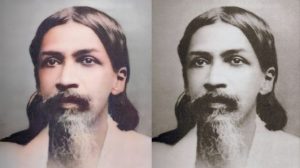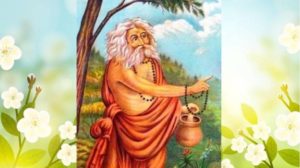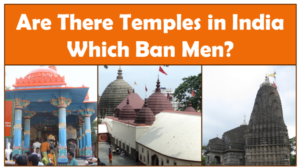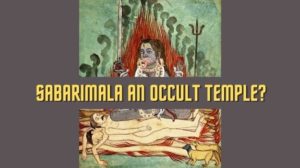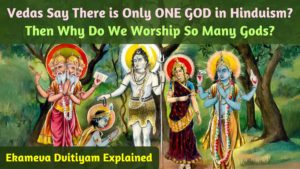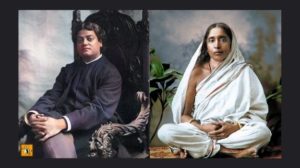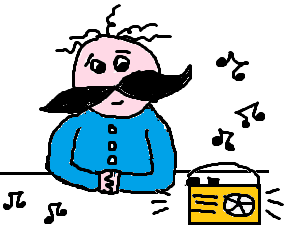The Banishment of Rama, Sita and Lakshmana into the Forest
At one time she had pleased the king very much, and he offered to grant her two boons: “Ask any two things in my power and I will grant them to you,” said he, but she made no request then.
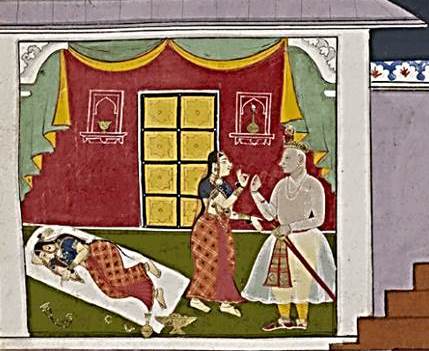
She had forgotten all about it; but the evil-minded maidservant in her employ began to work upon her jealousy with regard to Rama being installed on the throne, and insinuated to her how nice it would be for her if her own son had succeeded the king; until the queen was almost mad with jealousy.
Then the servant suggested to her to ask from the king the two promised boons: one would be that her own son Bharata should be placed on the throne, and the other, that Rama should be sent to the forest and be exiled for fourteen years.
Now, Rama was the life and soul of the old king and when this wicked request was made to him, he as a king felt he could not go back on his word. So he did not know what to do. But Rama came to the rescue and willingly offered to give up the throne and go into exile, so that his father might not be guilty of falsehood. So Rama went into exile for fourteen years, accompanied by his loving wife Sita and his devoted brother Lakshmana, who would on no account be parted from him.
The Aryans did not know who were the inhabitants of these wild forests. In those days the forest tribes they called “monkeys” (‘Vanaras’, which in Sanskrit means monkey-like), and some of the so-called “monkeys”, if unusually strong and powerful, were called “demons”.
So, into the forest, inhabited by demons and monkeys, Rama, Lakshmana and Sita went. When Sita had offered to accompany Rama, he exclaimed, “How can you, a princess, face hardships and accompany me into a forest full of unknown dangers!” But Sita replied, “Wherever Rama goes, there goes Sita. How can you talk of ‘princess’ and ‘royal birth’ to me? I go before you!” So, Sita went.
And the younger brother, he also went with them. They penetrated far into the forest, until they reached the river Godavari. On the banks of the river they built little cottages, and Rama and Lakshmana used to hunt deer and collect fruits.
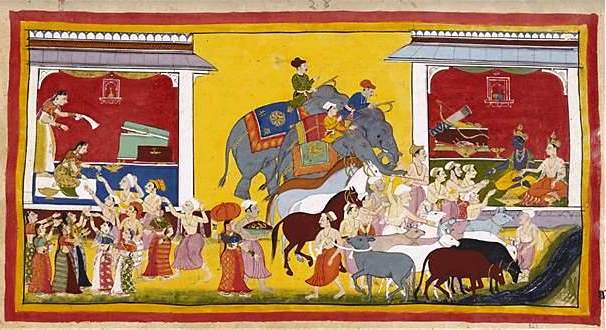
Abduction of Sita by the Demon Ravana
After they had lived thus for some time, one day there came a demon giantess. She was the sister of the giant king, Ravana of Lanka (Ceylon). Roaming through the forest at will, she came across Rama and seeing that he was a very handsome man, she fell in love with him at once. But Rama was the purest of men, and also he was a married man; so of course he could not return her love. In revenge, she went to her brother, the giant king Ravana, and told him all about the beautiful Sita, the wife of Rama.
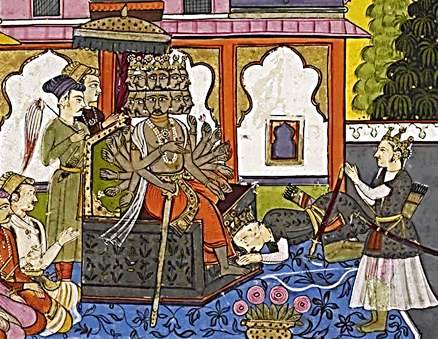
Rama was the most powerful of mortals; there were no giants or demons or anybody else strong enough to conquer him. So, the giant king had to resort to subterfuge.
He got hold of another giant who was a magician and changed him into a beautiful golden deer; and the deer went prancing round about the place where Rama lived, until Sita was fascinated by its beauty and asked Rama to go and capture the deer for her.
Rama went into the forest to catch the deer, leaving his brother in charge of Sita. Then Lakshmana laid a circle of fire round the cottage, and he said to Sita, “Today I see something may befall you; and, therefore, I tell you not to go outside of this magic circle. Some danger may befall you if you do.” In the meanwhile, Rama had pierced the magic deer with his arrow, and immediately the deer, changed into the form of a man and died.
Immediately, at the cottage was heard the voice of Rama, crying, “Oh, Lakshmana, come to my help!” and Sita said, “Lakshmana, go at once into the forest to help Rama!” “That is not Rama’s voice,” protested Lakshmana. But at the entreaties of Sita, Lakshmana had to go in search of Rama.
As soon as he went away, the giant king, who had taken the form of a mendicant monk, stood at the gate and asked for alms. “Wait awhile,” said Sita, “until my husband comes back and I will give you plentiful alms.” “I cannot wait, good lady,” said he, “I am very hungry, give me anything you have.”
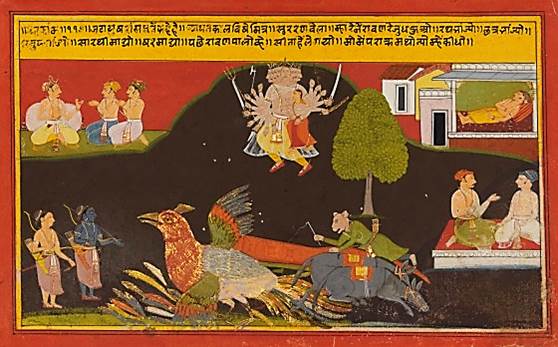
(This story of Jatayu has been omitted by Swami Vivekananda in his summary of the Ramayana.)
At this, Sita, who had a few fruits in the cottage, brought them out. But the mendicant monk after many persuasions prevailed upon her to bring the alms to him, assuring her that she need have no fear as he was a holy person.
So Sita came out of the magic circle, and immediately the seeming monk assumed his giant body, and grasping Sita in his arms he called his magic chariot, and putting her therein, he fled with the weeping Sita. Poor Sita! She was utterly helpless, nobody, was there to come to her aid. As the giant was carrying her away, she took off a few of the ornaments from her arms and at intervals dropped them to the grounds.
She was taken by Ravana to his kingdom, Lanka, the island of Ceylon (present day Sri Lanka). He made appeals to her to become his queen, and tempted her in many ways to accede to his request. But Sita who was chastity itself, would not even speak to the giant; and he to punish her, made her live under a tree, day and night, until she should consent to be his wife.
While Searching for Sita, Rama Meets the Devoted Hanuman
When Rama and Lakshmana returned to the cottage and found that Sita was not there, their grief knew no bounds. They could not imagine what had become of her. The two brothers went on, seeking, seeking everywhere for Sita, but could find no trace of her. After long searching, they came across a group of “monkeys”, and in the midst of them was Hanuman, the “divine monkey”.
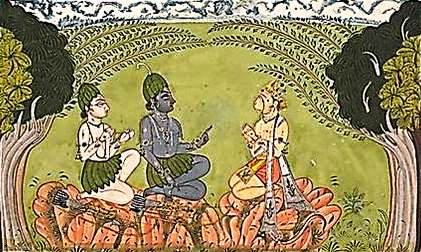
(Water-colour painting from Punjab dating to the early 1700’s, courtesy the Metropolitan Museum.)
Hanuman, the best of the monkeys, became the most faithful servant of Rama and helped him in rescuing Sita, as we shall see later on.
His devotion to Rama was so great that he is still worshiped by the Hindus as the ideal of a true servant of the Lord. You see, by the “monkeys” and “demons” are meant the aborigines of South India.
So, Rama, at last, fell in with these monkeys. They told him that they had seen flying through the sky a chariot, in which was seated a demon who was carrying away a most beautiful lady, and that she was weeping bitterly, and as the chariot passed over their heads she dropped one of her ornaments to attract their attention.
Then they showed Rama the ornament. Lakshmana took up the ornament, and said, “I do not know whose ornament this is.” Rama took it from him and recognized it at once, saying, “Yes, it is Sita’s.” Lakshmana could not recognize the ornament, because in India the wife of the elder brother was held in so much reverence that he had never looked upon the arms and the neck of Sita. So you see, as it was a necklace, he did not know whose it was. There is in this episode a touch of the old Indian custom. Then, the monkeys told Rama who this demon king was and where he lived, and then they all went to seek for him.
Hanuman Leaps Across the Ocean and Finds Sita Being Held Captive in Lanka
Now, the monkey-king Vali and his younger brother Sugriva were then fighting amongst themselves for the kingdom. The younger brother was helped by Rama, and he regained the kingdom from Vali, who had driven him away; and he, in return, promised to help Rama. They searched the country all round, but could not find Sita. At last Hanuman leaped by one bound from the coast of India to the island of Ceylon, and there went looking all over Lanka for Sita, but nowhere could he find her.
You see, this giant king had conquered the gods, the men, in fact the whole world; and he had collected all the beautiful women and made them his concubines. So, Hanuman thought to himself, “Sita cannot be with them in the palace. She would rather die than be in such a place.” So Hanuman went to seek for her elsewhere.
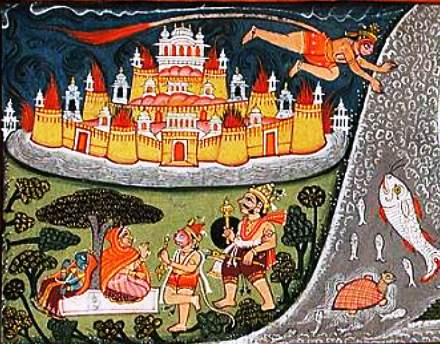
(Water-colour painting from Gujarat dating to the late 1700’s, courtesy the LACMA.)
At last, he found Sita under a tree, pale and thin, like the new moon that lies low in the horizon.
Now Hanuman took the form of a little monkey and settled on the tree, and there he witnessed how giantesses sent by Ravana came and tried to frighten Sita into submission, but she would not even listen to the name of the giant king.
Then, Hanuman came nearer to Sita and told her how he became the messenger of Rama, who had sent him to find out where Sita was; and Hanuman showed to Sita the signet ring which Rama had given as a token for establishing his identity.
He also informed her that as soon as Rama would know her whereabouts, he would come with an army and conquer the giant and recover her. However, he suggested to Sita that if she wished it, he would take her on his shoulders and could with one leap clear the ocean and get back to Rama. But Sita could not bear the idea, as she was chastity itself, and could not touch the body of any man except her husband. So, Sita remained where she was. But she gave him a jewel from her hair to carry to Rama; and with that Hanuman returned.
Rama Marches to Lanka and Kills Ravana
Learning everything about Sita from Hanuman, Rama collected an army, and with it marched towards the southernmost point of India. There Rama’s monkeys built a huge bridge, called Setu-Bandha, connecting India with Ceylon. In very low water even now it is possible to cross from India to Ceylon over the sand-banks there.
Now Rama was God incarnate, otherwise, how could he have done all these things? He was an Incarnation of God, according to the Hindus. They in India believe him to be the seventh Incarnation of God.
The monkeys removed whole hills, placed them in the sea and covered them with stones and trees, thus making a huge embankment. A little squirrel, so it is said, was there rolling himself in the sand and running backwards and forwards on to the bridge and shaking himself. Thus in his small way he was working for the bridge of Rama by putting in sand.
The monkeys laughed, for they were bringing whole mountains, whole forests, huge loads of sand for the bridge — so they laughed at the little squirrel rolling in the sand and then shaking himself. But Rama saw it and remarked: “Blessed be the little squirrel; he is doing his work to the best of his ability, and he is therefore quite as great as the greatest of you.” Then he gently stroked the squirrel on the back, and the marks of Rama’s fingers, running length-ways, are seen on the squirrel’s back to this day.
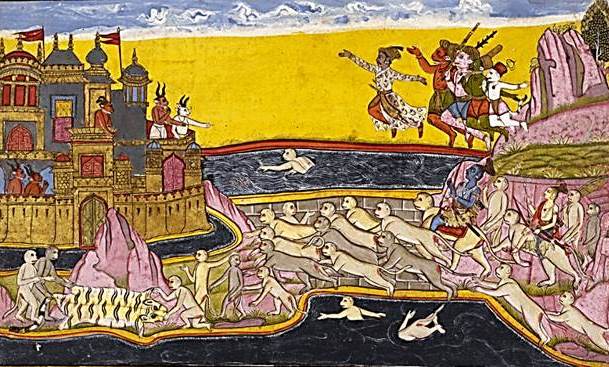
Now, when the bridge was finished, the whole army of monkeys, led by Rama and his brother entered Ceylon. For several months afterwards tremendous war and bloodshed followed. At last, this demon king, Ravana, was conquered and killed; and his capital, with all the palaces and everything, which were entirely of solid gold, was taken.
In far-away villages in the interior of India, when I tell them that I have been in Ceylon, the simple folk say, “There, as our books tell, the houses are built of gold.” So, all these golden cities fell into the hands of Rama, who gave them over to Vibhishana, the younger brother of Ravana, and seated him on the throne in the place of his brother, as a return for the valuable services rendered by him to Rama during the war.
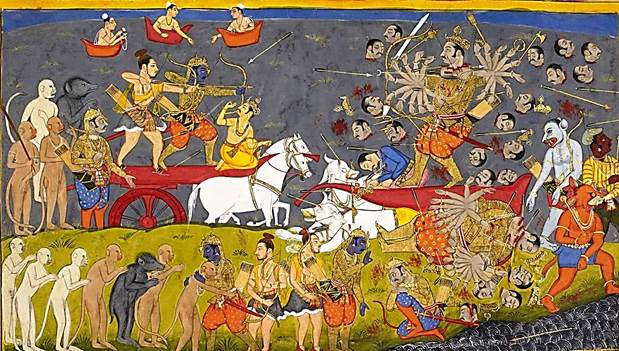
Ramayana Summary Continued | NEXT: Sita is Forced to Prove Her Chastity by the Fire Test >>

